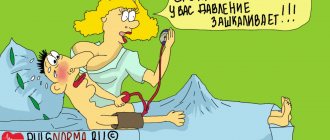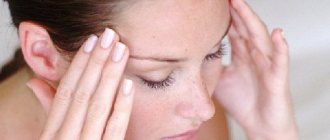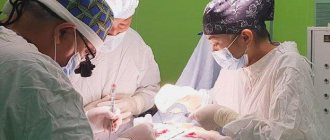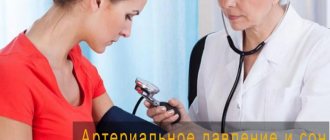30.11.2018
A.A.
(Last update: 01/21/2019)
There are contraindications. Specialist consultation required
A blood pressure of 220 over 140 is an extremely dangerous condition for any person. But not everyone knows what to do and how to behave correctly. Which organs and systems are affected first, what complications can develop, and what needs to be done in a critical situation. And also – is it possible to avoid a hypertensive crisis? Let's try to figure it out further.
The main causes of pressure 220/140
Unfortunately, in the modern world, most people of different ages suffer from high blood pressure, and such people are called hypertensive. The problem is that hypertension often occurs without any symptoms, but one day it will show itself with a hypertensive crisis - a sharp jump in blood pressure.
Do not self-medicate. Consult a specialist:
The norm is considered to be 120/80, however, slight fluctuations of 10-20 mmHg. may not be a serious pathology. But pressure readings of 220/140 can cause serious complications, leading to irreversible consequences, sometimes threatening human life and health. This is due to the fact that with such numbers the heart and blood vessels may not be able to cope with the increased load.
To assess the likely risks, it is important to know pulse pressure - this is the difference between systolic and diastolic pressure. Normal values are from 30 to 50 mm Hg. If pulse pressure is elevated, there is a high risk of a heart attack. If the pulse difference, on the contrary, decreases, then there is a risk of heart failure.
If, in addition to a pressure of 220 to 140, there is arrhythmia, rapid heartbeat, and painful phenomena in the chest, especially radiating to the left arm and shoulder, then the patient must be urgently hospitalized.
Factors leading to a rapid increase in pressure:
- Physical activity that is not typical for your body.
- Depressive or stressful situation. According to statistics, stress is one of the first causes of increased blood pressure.
- Burdened heredity.
- Physiological changes in the functioning of the cardiovascular system that occur with age. For example, in old age, the walls of blood vessels become not as elastic as before, so they cannot fully channel blood through the system, and resistance to blood flow increases.
- Kidney diseases (glomerulonephritis, pyelonephritis, etc.).
- Endocrine pathologies (thyrotoxicosis, hypothyroidism, diabetes mellitus, adrenal diseases).
- Tobacco smoking, excessive consumption of alcoholic beverages and strong coffee (the norm is 2 cups in the morning).
- Reaction to changes in weather conditions, climate change.
- Inactive lifestyle, sedentary work.
- Excess body weight.
- Non-compliance with the diet, consumption of large quantities of salt and sugar, as well as excess liquid.
You should not abruptly stop taking antihypertensive drugs that have been used for a long period of time, as changes in blood pressure may occur. During pregnancy, a woman's blood pressure may increase as a result of increased blood circulation and increased stress on the heart and blood vessels.
The exact cause of the sharp increase in pressure can only be determined by a specialist after a full medical examination and collection of anamnestic data. To do this, you need to check not only the heart and blood vessels, but also the functioning of the adrenal glands, kidneys, and thyroid gland. Ultrasound examinations are performed, and sometimes an MRI of the brain is indicated. All studies are carried out only after the symptoms of a hypertensive crisis are relieved.
Features of high blood pressure treatment
Several studies have confirmed that changes in eating and lifestyle habits reduce blood pressure and the risk of cardiovascular disease. Clear oral and written advice should be given to all patients with hypertension and documented high blood pressure.
Non-pharmacological measures can reduce blood pressure and enhance the effectiveness of pharmacological monotherapy. Nonpharmacological interventions reduce the need for medications, increase the antihypertensive effect of prescribed medications, reduce the need for multiple treatment regimens, and have a positive effect on overall cardiovascular risk. Conversely, failure to take these measures reduces the response to antihypertensive drugs and worsens the prognosis.
If antihypertensive pharmacotherapy is required in young patients with severe hypertension, non-pharmacological methods are prescribed in parallel with medical measures.
It is important to make timely lifestyle changes to lower blood pressure in order to avoid complications of hypertension.
Weight loss is recommended for most patients with hypertension, since a considerable percentage of them are obese. A decrease in body weight by 1 kg leads to a decrease in blood pressure by 2.5/1.5 mmHg. Art.
Obesity
Limiting salt intake from an average of 10 to 5 g/day (5 g is equivalent to one teaspoon) reduces blood pressure by 5/3 mmHg. Art. The effect is more pronounced in elderly patients and patients with initially higher blood pressure. All patients with hypertension should reduce their salt intake to 5 grams per day. However, salt does not have a negative effect on all patients. Hypertension from salt use occurs only in sensitive individuals.
Many patients have already given up adding salt to food at the table or during preparation, but few people know about the salt content in prepared foods: bread (one slice contains about 0.5 g of salt), some breakfast cereals and flavor enhancers (broth cubes, sauces, spice sets, etc.). Specific written materials should be provided to patients and those who cook for them (see also Patient Guidelines).
Hypertensive patients are advised to limit their alcohol intake to 21 units per week for men and 14 units per week for women (compared to 1 unit equal to approximately 1 glass of wine).
More than 21 units of alcohol increases blood pressure, this effect is reversible after reducing the doses consumed. Drinkers have an increased risk of stroke. In one study, limiting alcohol consumption reduced blood pressure in subjects. A small amount of alcohol (up to the recommended limit) protects against CHD.
Wine
The patient is advised to perform aerobic exercise rather than anaerobic exercise. Strength exercises can aggravate hypertension. Three sessions (0-45 minutes) of aerobic training per week is a suitable regimen for young patients, while forced walking of 20 minutes/day is sufficient for older patients.
The recommendation to increase the amount of fruits and vegetables in the diet is based on data from a controlled study. It showed that increasing the amount of fruit eaten from 2 to 7 servings per day significantly reduced blood pressure in patients with hypertension (by 7/3 mmHg).
The effect of fruits and vegetables on BP may be a consequence of increased potassium intake, although this process could not be clearly demonstrated in studies. Hypertensive patients should receive clear advice to increase the amount of fruits and vegetables in their daily diet.
When fruits and vegetables are combined in the diet with low-fat dairy products and the amount of saturated fat is reduced, the hypotensive effect reaches an average of 11/6 mmHg. Art. In patients with hypertension, even 4/2 mmHg. Art. considered a significant improvement. Consuming fish oil also helps lower blood pressure.
Many scientists claim that increasing the intake of potassium, magnesium and calcium lowers blood pressure, but this statement has not been conclusively proven. There are indications that reducing potassium intake increases blood pressure. The deficiency of this microelement is successfully compensated by adequate nutrition with a sufficient amount of fruits and vegetables.
Many patients try to explain high blood pressure as “stress.” However, scientists consider mental stress to be an indirect factor in the development of hypertension. There is evidence that autogenic training and stress management programs have hypotensive effects in hypertensive groups. The effectiveness of these procedures is comparable to drug therapy.
The above measures help lower blood pressure, but their beneficial effects on overall cardiovascular risk have not been well studied.
Smoking increases the risk of cardiovascular disease. Moderate hypertension and smoking are factors leading to a persistent increase in coronary mortality in men. Patients with hypertension who smoke should give up the bad habit. The use of nicotine replacement therapy doubles the number of recovered patients.
Nicotine patches are used in medicine. These drugs should not be used in patients with a myocardial infarction within the last 4 weeks, severe arrhythmias, or unstable angina. The dose should be adapted to the smoking regimen. With daily consumption of 15 cigarettes per day, the patient requires 2 mg/day. For more frequent smoking, the dose should be 4 mg/day per arm in the first 4 weeks, then 2 mg/day. There is no evidence of effectiveness to support patch treatment for more than 6 weeks.
Nicotine patches
Another predictor of CAD is serum cholesterol levels before and during antihypertensive therapy. All patients are advised to reduce their intake of cholesterol and saturated fats and replace them with monosaturated and polyunsaturated fatty acids. Low-cholesterol diets reduce cholesterol levels by an average of 6%. Dietary supplements with fish oil have positive effects on patients.
Many patients with arterial hypertension have a very high risk of developing coronary artery disease and therefore require treatment with acetylsalicylic acid (ASA) and statins. Such therapy is needed to prevent the occurrence of acute cardiovascular conditions.
Symptoms
An increase in blood pressure to 220/140 is often accompanied by general malaise, weakness and impaired autonomic function.
- Headache, predominantly of a pressing nature, especially in the back of the head. The peculiarity in this case is that it is not possible to relieve pain using analgesics or antispasmodics, since the pain is caused by poor blood supply to the brain and a decrease in vascular tone.
- Dizziness, spots flashing before the eyes.
- The limbs are cooled.
- Decreased visual acuity.
- Noise in ears.
- Facial redness.
- An increase in the number of heart contractions, arrhythmia is possible.
- Increased sweating.
- Nausea, vomiting.
- Panic attacks, anxiety. The patient feels the pulsation of his own blood in his ears and head, pain in his heart begins to frighten him, and fear for his life arises, which only worsens the situation.
In rare cases, clouding of consciousness, increased body temperature, convulsions, shortness of breath, hard breathing, and painful phenomena in the heart occur.
If a person suffers from high blood pressure for a long time, then the symptoms can be moderate and even erased. There are cases when, with a pressure of 220/140, the patient was bothered by a slight pain in the head, while irreversible consequences were already in full swing in the body. This is dangerous, therefore, at the slightest suspicion of hypertension, you need to take a tonometer and measure the pressure, and if it increases, call an ambulance.
Constantly elevated blood pressure
High blood pressure, even with numbers of 160 to 100, is not always felt by a person. Some people lead a normal lifestyle for a long time, unaware of the presence of hypertension. The disease manifests itself only during a hypertensive crisis, when the jump in blood pressure reaches prohibitive numbers.
Permanent hypertension is usually asymptomatic. There may be a headache and mild malaise, which is in no way associated with vascular problems. No medications are taken, no measurements are taken, and the disease continues to progress. And everything would be fine, but sooner or later it will lead to serious consequences in the form of:
- heart attack;
- heart failure;
- stroke;
- visual impairment;
- renal failure;
- pathological changes in cerebral circulation.
High blood pressure can lead to heart attack
Comfortable blood pressure is different for each person; in addition, it largely depends on age. Value 140–150/80–90 mmHg. Art. for an adult it can be considered the norm, provided that they are in good health. But the numbers 220 by 120 cannot possibly be normal. Moreover, they often indicate a developing hypertensive crisis that requires emergency medical care.
Over time, a person gets used to constant high blood pressure and stops noticing it. It would seem that this is good, there is no discomfort. But it's not that simple. At this time, the heart and blood vessels are under heavy load and wear out quickly. As a result, arrhythmia, angina pectoris, coronary heart disease, and a pre-infarction condition occur.
Constantly high blood pressure in any condition and at any age requires medical consultation and complex therapy.
Increased blood pressure and rapid pulse
Typically, with increased blood pressure, the heart rate always increases. This is how our heart tries to adapt to the increased blood pressure on the vascular walls. If the normal pulse is from 60 to 80 beats per minute, then with a pressure of 220 to 140 the number of beats can reach 100 or more.
However, there are completely opposite cases when, with increased pressure, the pulse goes beyond the lower limits of normal. This shows that the heart muscle is not coping with its task.
This is scary because when using antihypertensive drugs, for example, calcium channel blockers, not only the blood pressure decreases, but also the pulse, and if it is already low, then you can cause a heart attack, which will require urgent intervention from specialists and every second will be important. Therefore, it is important to pay attention to the pulse when measuring blood pressure.
What complications may arise?
Irreversible consequences appear that affect the kidneys, eyeballs, heart, blood vessels and brain. To avoid this, you need to stop the hypertensive surge in a timely manner.
Complications of pressure 220 to 140:
- Retinal angiopathy (impaired function of the blood supply to the eye, changes in the structure of the vascular wall), loss of vision;
- Stroke;
- Heart attack;
- Kidney and heart failure;
- Pulmonary edema.
According to statistics, providing medical care in the first 30 minutes makes it possible to reduce the likelihood of developing life-threatening consequences by 4 times!
Of particular note is the increase in blood pressure in women during pregnancy. Constant monitoring is important here, especially for women who have a history of hypertension or are currently experiencing it. Pressure should not be allowed to increase even to figures such as 160 to 120 mm Hg. This is a serious danger for both the unborn child and his mother. A woman should also not take medications on her own in case of high blood pressure. It is necessary to urgently consult a doctor and not refuse hospitalization, since even a single increase in pressure to 220 to 140 can cause acute oxygen starvation of the fetus and its death.
Hypertensive crisis: symptoms of manifestation
It was already mentioned above that increased pressure can provoke a hypertensive crisis. This is a patient's condition that requires immediate medical attention. GK can be complicated or uncomplicated. In the first case, a hypertensive crisis threatens the healthy functioning of the lungs, brain, and heart. A patient with a complicated hypertensive crisis should be taken to the hospital for immediate containment of the condition.
With an uncomplicated hypertensive crisis, the patient does not need to visit the hospital, because can stop HA on its own at home. The most important thing is to provide the patient with first aid in a timely manner.
How does blood pressure increase at different ages?
- If high blood pressure appears in childhood. We are definitely talking about kidney pathologies, heart defects and congenital anomalies of large vessels.
- In adolescence, the cause is often endocrinological diseases. This also includes hormonal imbalance, overeating, an inactive lifestyle - all this becomes the main factor for the development of primary hypertension, which is common today.
- After the age of 30, hypertension is already a multifactorial disease and can be controlled with antihypertensive drugs and lifestyle changes, since the main causes of the disease are stress, sedentary work, night shifts, etc.
- After the age of 40, the development of hypertension is dangerous due to its complications - the risk of heart attack and stroke increases. Therefore, at this age you need to control your blood pressure and take prescribed medications on time.
First aid
First of all, you need to quickly call an ambulance, and while you are waiting, you can take a number of measures:
- The patient should take a comfortable position - sitting (put a pillow under the lower back) or lying down (head raised).
- Provide fresh air access to the room.
- If the patient is chilling, cover him. You can take a warm foot bath for 10 minutes.
- If there is pain in the heart, then give nitroglycerin under the tongue.
- If the patient knows about his disease and takes a certain medicine prescribed by a specialist, then he must take it.
How to treat blood pressure 220 to 140
A doctor can prescribe treatment for high blood pressure with medications only after a comprehensive examination of the patient. In this case, the specialist must carefully select the exact dosage and type of drug, taking into account the patient’s age, weight, medical history and the presence of chronic pathologies.
What medications can be used to treat high blood pressure:
- Diuretics (diuretics) - remove unnecessary fluid from the body, relieve swelling. (“Furosemide”, “Indapamide”).
- Calcium channel blockers - reduce the contraction of vascular walls, due to which the vessels dilate and blood flow is restored. (“Nifedipine”, “Verapamil”).
- Angiotensin-converting enzyme inhibitors (“Enalapril”, “Enap”).
- Beta and alpha adrenergic blockers. They reduce the pulse, improve vascular conductivity, relieve tension in the heart muscle and block the effect of adrenaline on the vascular walls. (“Bisoprolol”, “Timolol”, “Metoprolol”).
As an aid, the doctor may recommend a tincture of medicinal herbs. It could be motherwort, peony or valerian. They have a calming effect.
Never self-medicate. Some people simply find out the name of antihypertensive drugs from pharmacists and take them when their blood pressure rises. This is not only wrong, but also extremely dangerous. Simply lowering blood pressure is not a treatment, it is an elimination of symptoms, and in this disease it is important to find the cause of its increase and eliminate it. By self-medicating, patients only aggravate the situation, increasing the risk of severe consequences, including death.
What should a hypertensive patient do?
A person who has hypertension or has had blood pressure rise to 220/140 at least once must adhere to the following rules:
- Eat healthy. Avoid salty and sweet foods and fast foods. Eat more vegetables, fruits, greens.
- Eliminate bad habits from your life.
- If you are overweight, get rid of it. Start playing sports, dancing, running, swimming, race walking - whatever you like. Do physical exercises in the fresh air, so your organs and tissues will be more quickly saturated with oxygen and nutrients. That is, the main rule is to constantly move.
- Follow a work and rest schedule. Even if you work continuously and for a long time at the computer, always take a few minutes to relax, stand up, move around and restore normal blood circulation.
- Monitor your blood pressure and take medications prescribed by your doctor, and visit specialists in a timely manner.
Know that only you can fully take care of your health!
How to lower and normalize blood pressure?
First of all, if you have high blood pressure, you should measure your blood pressure a couple of times a day. Next, you should know which medications you need to use. It is also important to change the way you live. The following recommendations should be followed:
- Proper nutrition: reduce consumption of fatty, fried and salty foods.
- Physical activity: it is necessary to perform exercises designed to restore the body after disturbances in the functioning of the heart and blood vessels.
- Stop drinking coffee.
- Get rid of bad habits.









